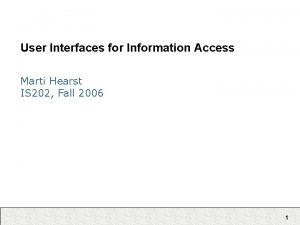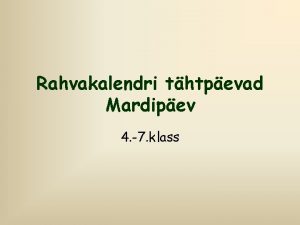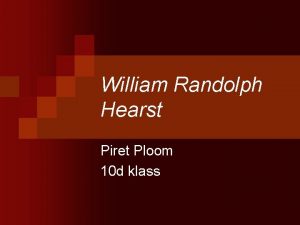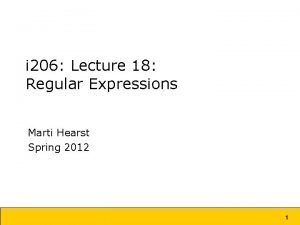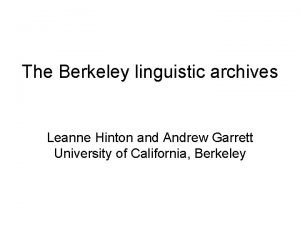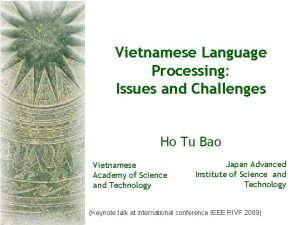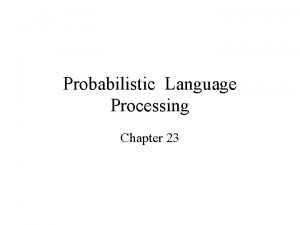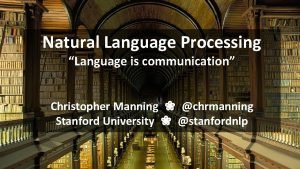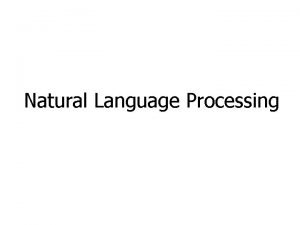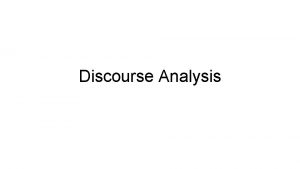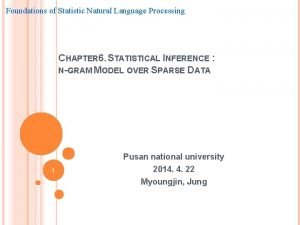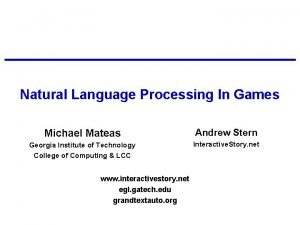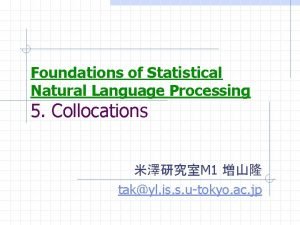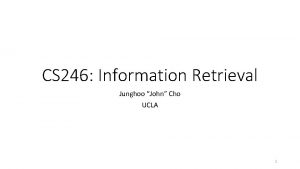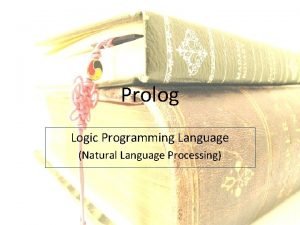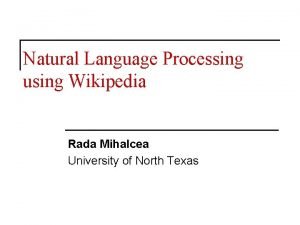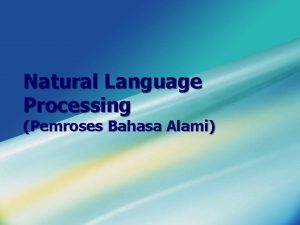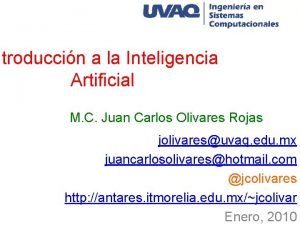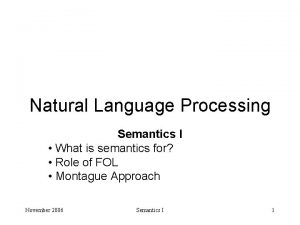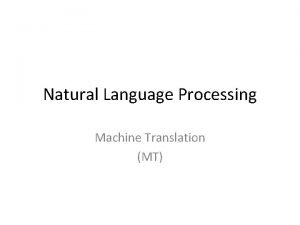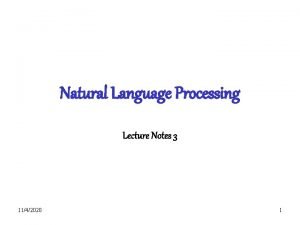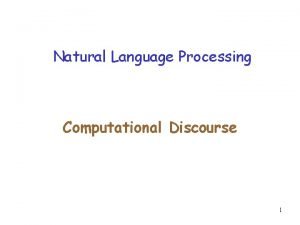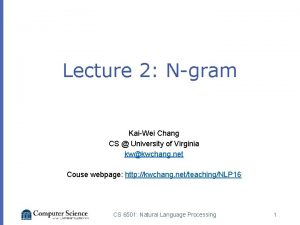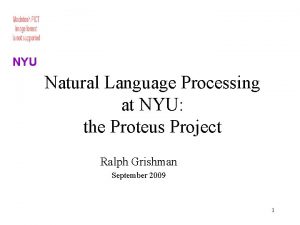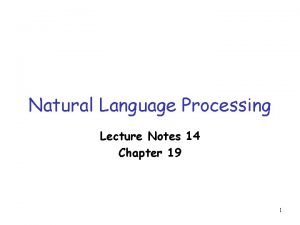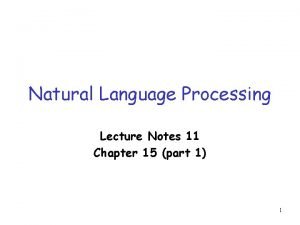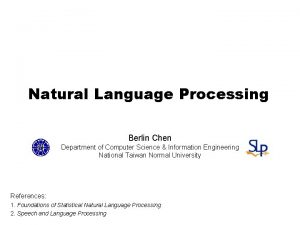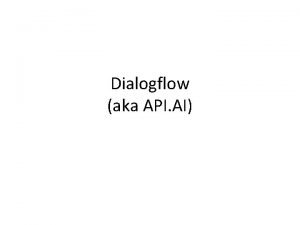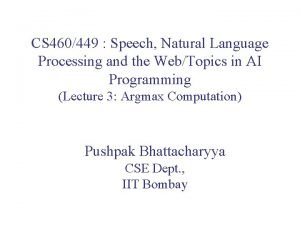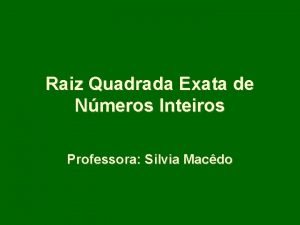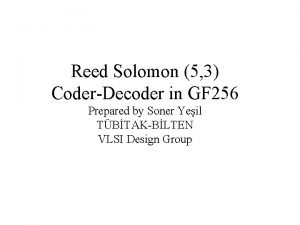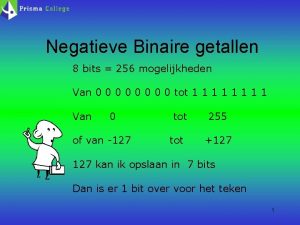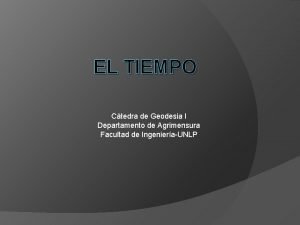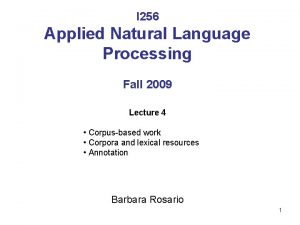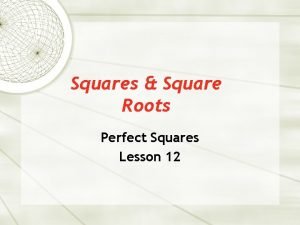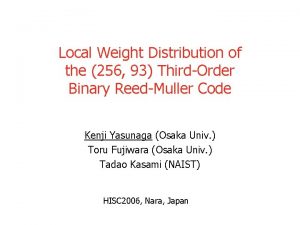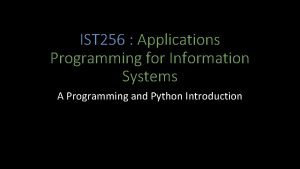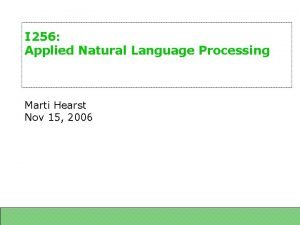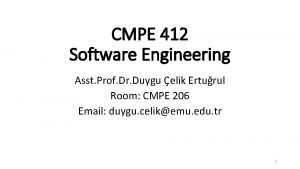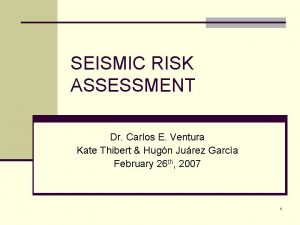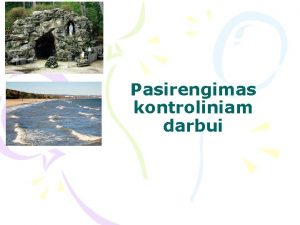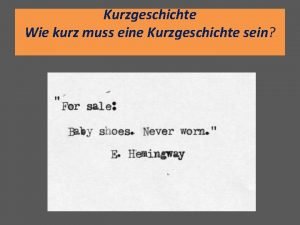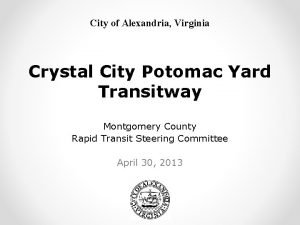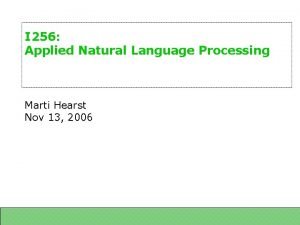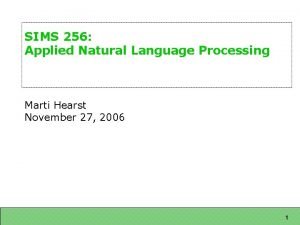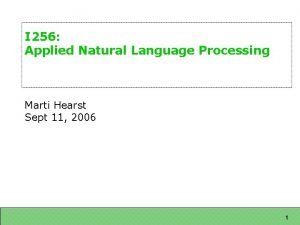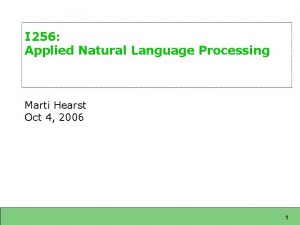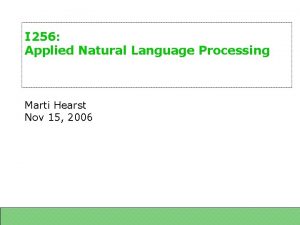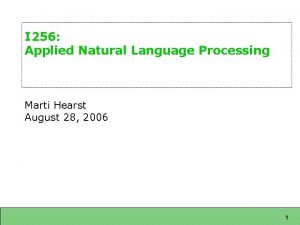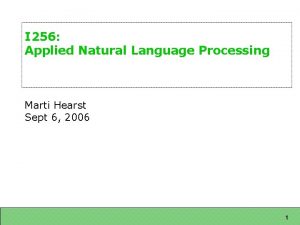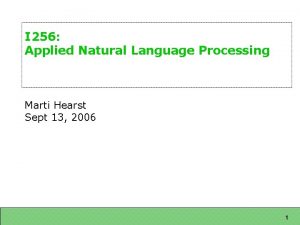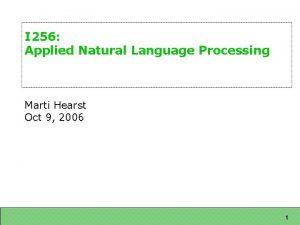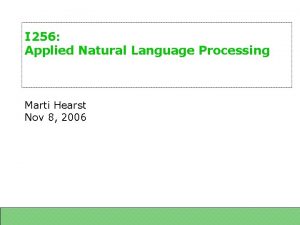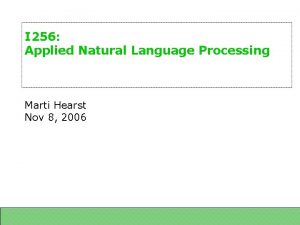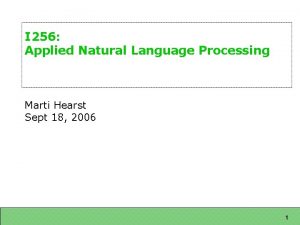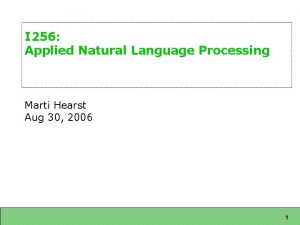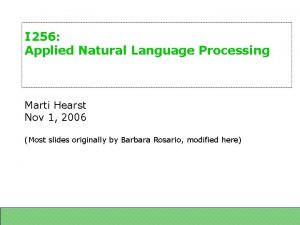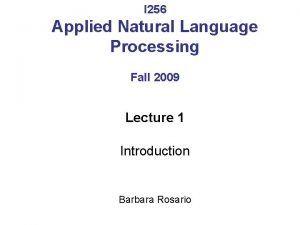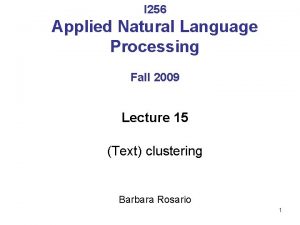I 256 Applied Natural Language Processing Marti Hearst

































































- Slides: 65

I 256: Applied Natural Language Processing Marti Hearst Nov 6, 2006

Today Text Clustering Latent Semantic Indexing (LSA) 2

Text Clustering Finds overall similarities among groups of documents Finds overall similarities among groups of tokens Picks out some themes, ignores others 3

Text Clustering is “The art of finding groups in data. ” -- Kaufmann and Rousseeu Term 1 Term 2 4

Text Clustering is “The art of finding groups in data. ” -- Kaufmann and Rousseeu Term 1 Term 2 5

Clustering Applications Find semantically related words by combining similarity evidence from multiple indicators Try to find overall trends or patterns in text collections Slide by Vasileios Hatzivassiloglou 6

“Training” in Clustering is an unsupervised learning method For each data set, a totally fresh solution is constructed Therefore, there is no training However, we often use some data for which we have additional information on how it should be partitioned to evaluate the performance of the clustering method Slide by Vasileios Hatzivassiloglou 7

Pair-wise Document Similarity nova A B C D galaxy 1 3 5 2 heat h’wood film role 2 1 5 4 1 diet fur 1 How to compute document similarity? 8

Pair-wise Document Similarity (no normalization for simplicity) nova A B C D galaxy 1 3 5 2 heat h’wood film role 2 1 5 4 1 diet fur 1 9

Pair-wise Document Similarity (cosine normalization) 10

Document/Document Matrix 11

Hierarchical clustering methods Agglomerative or bottom-up: Start with each sample in its own cluster Merge the two closest clusters Repeat until one cluster is left Divisive or top-down: Start with all elements in one cluster Partition one of the current clusters in two Repeat until all samples are in singleton clusters Slide by Vasileios Hatzivassiloglou 12

Agglomerative Clustering A B C D E F G H I 13

Agglomerative Clustering A B C D E F G H I 14

Agglomerative Clustering A B C D E F G H I 15

Merging Nodes Each node is a combination of the documents combined below it We represent the merged nodes as a vector of term weights This vector is referred to as the cluster centroid Slide by Vasileios Hatzivassiloglou 16

Merging criteria We need to extend the distance measure from samples to sets of samples The complete linkage method The single linkage method The average linkage method Slide by Vasileios Hatzivassiloglou 17

Single-link merging criteria merge each word type is a single-point cluster Merge closest pair of clusters: Single-link: clusters are close if any of their points are dist(A, B) = min dist(a, b) for a A, b B 18

Bottom-Up Clustering – Single-Link Fast, but tend to get long, stringy, meandering clusters . . . 19

Bottom-Up Clustering – Complete-Link distance between clusters Again, merge closest pair of clusters: Complete-link: clusters are close only if all of their points are dist(A, B) = max dist(a, b) for a A, b B 20

Bottom-Up Clustering – Complete-Link distance between clusters Slow to find closest pair – need quadratically many distances 21

K-Means Clustering Decide on a pair-wise similarity measure 2 Find K centers using agglomerative clustering 1 take a small sample group bottom up until K groups found 3 Assign each document to nearest center, forming new clusters 4 Repeat 3 as necessary 22

k-Medians Similar to k-means but instead of calculating the means across features, it selects as ci the sample in cluster Ci that minimizes (the median) Advantages Does not require feature vectors Distance between samples is always available Statistics with medians are more robust than statistics with means Slide by Vasileios Hatzivassiloglou 23

Choosing k In both hierarchical and k-means/medians, we need to be told where to stop, i. e. , how many clusters to form This is partially alleviated by visual inspection of the hierarchical tree (the dendrogram) It would be nice if we could find an optimal k from the data We can do this by trying different values of k and seeing which produces the best separation among the resulting clusters. Slide by Vasileios Hatzivassiloglou 24

Scatter/Gather: Clustering a Large Text Collection Cutting, Pedersen, Tukey & Karger 92, 93 Hearst & Pedersen 95 Cluster sets of documents into general “themes”, like a table of contents Display the contents of the clusters by showing topical terms and typical titles User chooses subsets of the clusters and re-clusters the documents within Resulting new groups have different “themes” 25

S/G Example: query on “star” Encyclopedia text 8 symbols 68 film, tv (p) 97 astrophysics 67 astronomy(p) 10 flora/fauna 14 sports 47 film, tv 7 music 12 steller phenomena 49 galaxies, stars 29 constellations 7 miscelleneous Clustering and re-clustering is entirely automated 26




Clustering Retrieval Results Tends to place similar docs together So can be used as a step in relevance ranking But not great for showing to users Exception: good for showing what to throw out! 30

Another use of clustering Use clustering to map the entire huge multidimensional document space into a huge number of small clusters. “Project” these onto a 2 D graphical representation Looks neat, but doesn’t work well as an information retrieval interface. 31

Clustering Multi-Dimensional Document Space (image from Wise et al 95) 32

How to evaluate clusters? In practice, it’s hard to do Different algorithms’ results look good and bad in different ways It’s difficult to distinguish their outcomes In theory, define an evaluation function Typically choose something easy to measure (e. g. , the sum of the average distance in each class) 33

Two Types of Document Clustering Grouping together of “similar” objects Hard Clustering -- Each object belongs to a single cluster Soft Clustering -- Each object is probabilistically assigned to clusters Slide by Inderjit S. Dhillon 34

Soft clustering A variation of many clustering methods Instead of assigning each data sample to one and only one cluster, it calculates probabilities of membership for all clusters So, a sample might belong to cluster A with probability 0. 4 and to cluster B with probability 0. 6 Slide by Vasileios Hatzivassiloglou 35

Application: Clustering of adjectives Cluster adjectives based on the nouns they modify Multiple syntactic clues for modification The similarity measure is Kendall’s τ, a robust measure of similarity Clustering is done via a hill-climbing method that minimizes the combined average dissimilarity Predicting the semantic orientation of adjectives, V Hatzivassiloglou, KR Mc. Keown, EACL 1997 Slide by Vasileios Hatzivassiloglou 36

Clustering of nouns Work by Pereira, Tishby, and Lee Dissimilarity is KL divergence Asymmetric relationship: nouns are clustered, verbs which have the nouns as objects serve as indicators Soft, hierarchical clustering Slide by Vasileios Hatzivassiloglou 37

Distributional Clustering of English Words - Pereira, Tishby and Lee, ACL 93

Distributional Clustering of English Words - Pereira, Tishby and Lee, ACL 93

Latent Semantic Analysis Mathematical/statistical technique for extracting and representing the similarity of meaning of words Represents word and passage meaning as highdimensional vectors in the semantic space Uses Singular Value Decomposition (SVD) to simulate human learning of word and passage meaning Its success depends on: Sufficient scale and sampling of the data it is given Choosing the right number of dimensions to extract Slide by Kostas Kleisouris 40

LSA Characteristics Why is reducing dimensionality beneficial? Some words with similar occurrence patterns are projected onto the same dimension Closely mimics human judgments of meaning similarity Slide by Schone, Jurafsky, and Stenchikova 41

Sample Applications of LSA Essay Grading LSA is trained on a large sample of text from the same domain as the topic of the essay Each essay is compared to a large set of essays scored by experts and a subset of the most similar identified by LSA The target essay is assigned a score consisting of a weighted combination of the scores for the comparison essays Slide by Kostas Kleisouris 42

Sample Applications of LSA Prediction of differences in comprehensibility of texts By using conceptual similarity measures between successive sentences LSA has predicted comprehension test results with students Evaluate and give advice to students as they write and revise summaries of texts they have read Assess psychiatric status By representing the semantic content of answers to psychiatric interview questions Slide by Kostas Kleisouris 43

Sample Applications of LSA Improving Information Retrieval Use LSA to match users’ queries with documents that have the desired conceptual meaning Not used in practice – doesn’t help much when you have large corpora to match against, but maybe helpful for a few difficult queries and for term expansion Slide by Kostas Kleisouris 44

LSA intuitions Implements the idea that the meaning of a passage is the sum of the meanings of its words: meaning of word 1 + meaning of word 2 + … + meaning of wordn = meaning of passage This “bag of words” function shows that a passage is considered to be an unordered set of word tokens and the meanings are additive. By creating an equation of this kind for every passage of language that a learner observes, we get a large system of linear equations. Slide by Kostas Kleisouris 45

LSA Intuitions However Too few equations to specify the values of the variables Different values for the same variable (natural since meanings are vague or multiple) Instead of finding absolute values for the meanings, they are represented in a richer form (vectors) Use of SVD (reduces the linear system into multidimensional vectors) Slide by Kostas Kleisouris 46

Latent Semantic Analysis A trick from Information Retrieval Each document in corpus is a length-k vector – Or each paragraph, or whatever d e n rk s o a v acu nd ot uct ve d r b a a ab abd abo a (0, 3, 3, 1, 0, 7, . . . y g e r t u o g m zy zy 1, 0) a single document Slide by Jason Eisner 47

Latent Semantic Analysis A trick from Information Retrieval Each document in corpus is a length-k vector Plot all documents in corpus Reduced-dimensionality plot Slide by Jason Eisner True plot in k dimensions 48

Latent Semantic Analysis Reduced plot is a perspective drawing of true plot It projects true plot onto a few axes a best choice of axes – shows most variation in the data. Found by linear algebra: “Singular Value Decomposition” (SVD) Reduced-dimensionality plot Slide by Jason Eisner True plot in k dimensions 49

Latent Semantic Analysis SVD plot allows best possible reconstruction of true plot (i. e. , can recover 3 -D coordinates with minimal distortion) Ignores variation in the axes that it didn’t pick out Hope that variation’s just noise and we want to ignore it True plot in k dimensions theme A Slide by Jason Eisner theme word 2 theme B B Reduced-dimensionality plot theme A 3 d r o w word 1 50

Latent Semantic Analysis SVD finds a small number of theme vectors Approximates each doc as linear combination of themes Coordinates in reduced plot = linear coefficients How much of theme A in this document? How much of theme B? Each theme is a collection of words that tend to appear together theme A Slide by Jason Eisner True plot in k dimensions B theme B Reduced-dimensionality plot 51

Latent Semantic Analysis Another perspective (similar to neural networks): terms 1 2 3 4 5 6 7 8 9 matrix of strengths (how strong is each term in each document? ) 1 2 3 4 5 6 7 documents Slide by Jason Eisner Each connection has a weight given by the matrix. 52

Latent Semantic Analysis Which documents is term 5 strong in? terms 1 2 3 4 5 6 7 8 9 docs 2, 5, 6 light up strongest. 1 2 3 4 5 6 7 documents Slide by Jason Eisner 53

Latent Semantic Analysis Which documents are terms 5 and 8 strong in? terms 1 2 3 4 5 6 7 8 9 This answers a query consisting of terms 5 and 8! 1 2 3 4 5 6 7 documents Slide by Jason Eisner really just matrix multiplication: term vector (query) x strength matrix = doc vector 54

Latent Semantic Analysis Conversely, what terms are strong in document 5? terms 1 2 3 4 5 6 7 8 9 gives doc 5’s coordinates! 1 2 3 4 5 6 7 documents Slide by Jason Eisner 55

Latent Semantic Analysis SVD approximates by smaller 3 -layer network Forces sparse data through a bottleneck, smoothing it terms 1 2 3 4 5 6 7 8 9 themes 1 2 3 4 5 6 7 documents Slide by Jason Eisner 1 2 3 4 5 6 7 documents 56

Latent Semantic Analysis I. e. , smooth sparse data by matrix approx: M A B A encodes camera angle, B gives each doc’s new coords terms 1 2 3 4 5 6 7 8 9 matrix M 1 2 3 4 5 6 7 documents Slide by Jason Eisner A themes B 1 2 3 4 5 6 7 documents 57

How LSA works Takes as input a corpus of natural language The corpus is parsed into meaningful passages (such as paragraphs) A matrix is formed with passages as rows and words as columns. Cells contain the number of times that a given word is used in a given passage The cell values are transformed into a measure of the information about the passage identity the carry SVD is applied to represent the words and passages as vectors in a high dimensional semantic space Slide by Kostas Kleisouris 58

Represent text as a matrix words documents d 1 d 2 d 3 d 4 d 5 d 6 cosmonaut 1 0 0 0 astronaut 0 1 0 0 moon 1 1 0 0 car 1 0 0 1 1 0 truck 0 0 0 1 A[i, j] = number of of occurrence of a word i in document j Slide by Schone, Jurafsky, and Stenchikova 59

SVD {A}={T}{S}{D}’ m n A m =n T Min(n, m) x S n x m D’ k §Reduce dimensionality to k and compute A 1: m n A 1 k = n T 1 x k k S x k m D’ A 1 is the best least square approximation of A by a matrix in rank k Slide by Schone, Jurafsky, and Stenchikova 60

Matrix T words T- term matrix. Rows of T correspond to Rows of original matrix A dimensions dim 1 dim 2 dim 3 dim 4 dim 5 cosmonaut -0. 44 -0. 30 0. 57 0. 58 0. 25 astronaut -0. 13 -0. 33 -0. 59 0. 00 0. 73 moon -0. 48 -0. 51 -0. 37 0. 00 -0. 61 car -0. 70 0. 35 0. 15 -0. 58 0. 16 truck -0. 26 0. 65 -0. 41 0. 58 -0. 09 Dim 2 directly reflects the different co-occurrence patterns Slide by Schone, Jurafsky, and Stenchikova

Matrix D’ dimensions D- document matrix. Columns of D’ (rows of D) correspond to rows of original matrix A documents d 1 d 2 d 3 d 4 d 5 d 6 Dimension 1 -0. 75 -0. 28 -0. 20 -0. 45 -0. 33 -0. 12 Dimension 2 -0. 29 -053 -0. 19 0. 63 0. 22 0. 41 Dimension 3 0. 28 -0. 75 0. 45 -0. 20 0. 12 -0. 33 Dimension 4 -0. 00 0. 58 0. 00 -0. 58 Dimension 5 -0. 53 0. 29 0. 63 0. 19 0. 41 -0. 22 Dim 2 directly reflects the different co-occurrence patterns Slide by Schone, Jurafsky, and Stenchikova 62

Reevaluating document similarities B = S 1 x D 1 Matrix B is a dimensionality reduction of the original matrix A Compute document correlation B’*B d 1 d 2 d 3 d 4 d 5 d 1 1 d 2 0. 78 1 d 3 0. 40 0. 88 1 d 4 0. 47 -0. 18 -0. 62 1 d 5 0. 74 0. 16 -0. 32 0. 94 1 d 6 0. 10 -0. 54 -0. 87 0. 93 0. 74 Slide by Schone, Jurafsky, and Stenchikova d 6 1 63

Unfolding new documents Given a new document, how to determine which documents it is similar to? A = T S D’ T’A = T’ T S D’ T’ A = S D’ q a new vector in the space of A q in reduced space = Slide by Schone, Jurafsky, and Stenchikova T’ * q 64

Next Time Several takes on blog analysis Sentiment classification 65
 Marti a. hearst
Marti a. hearst Marti hearst
Marti hearst Mardipäeva viktoriin
Mardipäeva viktoriin Hearst tower structure analysis
Hearst tower structure analysis William randolph hearst
William randolph hearst Hearst patterns python
Hearst patterns python Leanne hinton
Leanne hinton Natural language processing vietnamese
Natural language processing vietnamese Probabilistic model natural language processing
Probabilistic model natural language processing Natural language processing
Natural language processing Markov chain nlp
Markov chain nlp Christopher manning nlp
Christopher manning nlp Contoh bahasa alami
Contoh bahasa alami Buy nlu
Buy nlu Natural language processing lecture notes
Natural language processing lecture notes Foundations of statistical natural language processing
Foundations of statistical natural language processing Natural language processing fields
Natural language processing fields Statistical nlp
Statistical nlp Natural language processing nlp - theory lecture
Natural language processing nlp - theory lecture Façade michael mateas
Façade michael mateas Foundation collocation
Foundation collocation Cs 246
Cs 246 Prologn
Prologn Natural language processing wikipedia
Natural language processing wikipedia Pengertian natural language
Pengertian natural language Natural language processing
Natural language processing Nlp text similarity
Nlp text similarity Logical form
Logical form Dot translation
Dot translation Natural language processing lecture notes
Natural language processing lecture notes Reference phenomena in nlp
Reference phenomena in nlp Kaiwei chang
Kaiwei chang Nyu natural language processing
Nyu natural language processing Natural language processing lecture notes
Natural language processing lecture notes Natural language processing lecture notes
Natural language processing lecture notes Nlp berlin
Nlp berlin Dialogflow prebuilt agents
Dialogflow prebuilt agents Natural language processing
Natural language processing Raiz quadrada exata de números inteiros
Raiz quadrada exata de números inteiros Resolución 256 de 2018
Resolución 256 de 2018 4^x = 256
4^x = 256 Quran 2:256
Quran 2:256 452 sayısının en yakın yüzlüğü
452 sayısının en yakın yüzlüğü 十二進制
十二進制 Gf(256)
Gf(256) 8 bit 256
8 bit 256 Sha256digest
Sha256digest El año sideral dura 365. 256 días solares medios
El año sideral dura 365. 256 días solares medios Vlookup reference error 256 columns
Vlookup reference error 256 columns I^256
I^256 Is 256 a perfect square
Is 256 a perfect square 256+93
256+93 Ist 256
Ist 256 I^256
I^256 Rasianews
Rasianews Alas sebuah limas berbentuk persegi dengan luas 256
Alas sebuah limas berbentuk persegi dengan luas 256 Duygu çelik ertuğrul
Duygu çelik ertuğrul Jose marti ubc
Jose marti ubc Zemaites marti pagrindine mintis
Zemaites marti pagrindine mintis Luni marți miercuri joi vineri sâmbătă duminică
Luni marți miercuri joi vineri sâmbătă duminică Kurt marti happy end interpretation
Kurt marti happy end interpretation Gary marti
Gary marti Alexandria crystal peak
Alexandria crystal peak Zemaite marti pagrindine mintis
Zemaite marti pagrindine mintis Escola jaume balmes sant martí sarroca
Escola jaume balmes sant martí sarroca Fünfzehn reiner kunze charakterisierung
Fünfzehn reiner kunze charakterisierung

